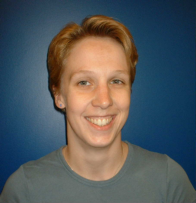Detection strategies for bioassays based on enzyme-amplified lanthanide luminescence
Promotion Date: 24 June 2004
| I’ll try to explain from the beginning. Lanthanides are part of the so-called rare earth metals. Some of them fluorescence in the dark if you radiate them with light at a certain wavelength. Because it is hard to excite the ‘naked’ metal ions we add an organic ligand to the metal forming a complex, which we then irradiate with light. The ligand absorbs the light and transfers the absorbed energy onto the metal ion, which then exhibits lanthanide luminescence. I used these complexes for the determination of enzymes. |
What was your thesis about?
I’ll try to explain from the beginning. Lanthanides are part of the so-called rare earth metals. Some of them fluorescence in the dark if you radiate them with light at a certain wavelength. Because it is hard to excite the ‘naked’ metal ions we add an organic ligand to the metal forming a complex, which we then irradiate with light. The ligand absorbs the light and transfers the absorbed energy onto the metal ion, which then exhibits lanthanide luminescence. I used these complexes for the determination of enzymes. The ligand is formed in an enzymatic reaction previous to the luminescence measurements and so it is possible to draw some conclusions about the enzyme concentration/activity.
What is the purpose of this?
Enzymes are often used as labels in immunoassays. Clinical chemists perform those assays in order to detect and identify diseases, employing an antibody-antigen reaction. Either the antibody or the antigen is labelled by an enzyme. If the antibody-antigen reaction took place, the enzyme reacts, in my case, with ligand present in the assay solution yielding lanthanide luminescence. The luminescence is read out and so it is possible to detect whether the antibody-antigen reaction took place or not.
I take it that chemistry is your background?
Yes, I am an analytical chemist.
Is this technique new?
This enzyme amplified lanthanide luminescence technique was first mentioned in literature in 1991. My work was to search for new ligands. It is not possible to use every organic ligand. It must be able to transfer the energy onto the metal ion. For my diploma thesis (Master’s Degree) I screened a lot of organic ligands in order to find one on the basis of which I could develop an enzyme amplified lanthanide luminescence system. In my Doctoral thesis I used among others one ligand, which was already literature known, but that one was not used in an enzyme amplified luminescence system before.
So this is very important for medical systems, or does it have other applications as well?
Mostly medical. Unfortunately, I did not work with any real samples yet. A collaboration with medical groups was in my research still a bit premature. I hope it will be put into practice.
What did you like most about your research?
Well, I like these complicated things, it is not what everybody is doing. It is quite exceptional. In the whole world there are only few groups using this enzyme amplified lanthanide luminescence. But it is hard to explain what makes it so very interesting.
What didn’t you like?
Apart from interesting, it is also laborious work, especially in the beginning when you have to search your ligand, screening a lot of substances.
Where are you from?
I am from the Osnabrück area. I started my studies at the Westfälische Wilhelms University in Münster and came here with Professor Uwe Karst. I was quite happy with the move, and our group had a really warm welcome by the people who were already working here.
What are you going to do next?
I don’t know yet. I am writing applications right now. I think I would like to go back to Germany and work in industry.
But since your promotion work is rare, will people recognize your specific qualifications?
I don’t really expect to work later in a field, which is related to the work I performed during my Ph D time. Fortunately I am also familiar with more common analytical techniques.

